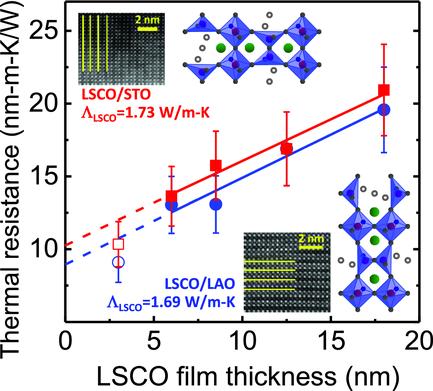当前位置:
X-MOL 学术
›
Adv. Funct. Mater.
›
论文详情
Our official English website, www.x-mol.net, welcomes your feedback! (Note: you will need to create a separate account there.)
Glass‐Like Through‐Plane Thermal Conductivity Induced by Oxygen Vacancies in Nanoscale Epitaxial La0.5Sr0.5CoO3−δ
Advanced Functional Materials ( IF 19.0 ) Pub Date : 2017-11-02 , DOI: 10.1002/adfm.201704233 Xuewang Wu 1 , Jeff Walter 2 , Tianli Feng 3 , Jie Zhu 1 , Hong Zheng 4 , John F. Mitchell 4 , Neven Biškup 5 , Maria Varela 5 , Xiulin Ruan 3 , Chris Leighton 2 , Xiaojia Wang 1
Advanced Functional Materials ( IF 19.0 ) Pub Date : 2017-11-02 , DOI: 10.1002/adfm.201704233 Xuewang Wu 1 , Jeff Walter 2 , Tianli Feng 3 , Jie Zhu 1 , Hong Zheng 4 , John F. Mitchell 4 , Neven Biškup 5 , Maria Varela 5 , Xiulin Ruan 3 , Chris Leighton 2 , Xiaojia Wang 1
Affiliation

|
Ultrafast time‐domain thermoreflectance (TDTR) is utilized to extract the through‐plane thermal conductivity (ΛLSCO) of epitaxial La0.5Sr0.5CoO3−δ (LSCO) of varying thickness (<20 nm) on LaAlO3 and SrTiO3 substrates. These LSCO films possess ordered oxygen vacancies as the primary means of lattice mismatch accommodation with the substrate, which induces compressive/tensile strain and thus controls the orientation of the oxygen vacancy ordering (OVO). TDTR results demonstrate that the room‐temperature ΛLSCO of LSCO on both substrates (1.7 W m−1 K−1) are nearly a factor of four lower than that of bulk single‐crystal LSCO (6.2 W m−1 K−1). Remarkably, this approaches the lower limit of amorphous oxides (e.g., 1.3 W m−1 K−1 for glass), with no dependence on the OVO orientation. Through theoretical simulations, origins of the glass‐like thermal conductivity of LSCO are revealed as a combined effect resulting from oxygen vacancies (the dominant factor), Sr substitution, size effects, and the weak electron/phonon coupling within the LSCO film. The absence of OVO dependence in the measured ΛLSCO is rationalized by two main effects: (1) the nearly isotropic phononic thermal conductivity resulting from the imperfect OVO planes when δ is small; (2) the missing electronic contribution to ΛLSCO along the through‐plane direction for these ultrathin LSCO films on insulating substrates.
中文翻译:

氧空位在纳米级外延La0.5Sr0.5CoO3-δ中诱导的类似玻璃的平面热导率
超快时域热反射(TDTR)被用来提取穿过平面的导热率(Λ LSCO外延的La)0.5锶0.5 CoO的3- δ上LaAlO中变化的厚度(<20纳米)的(LSCO)3和的SrTiO 3个基片。这些LSCO薄膜具有有序的氧空位,作为与基板晶格失配的主要手段,这会引起压缩/拉伸应变,从而控制氧空位有序(OVO)的方向。TDTR结果表明,室温Λ LSCO在两个基底上的LSCO(1.7脉冲W M -1 ķ -1)比单晶LSCO(6.2 W m -1 K -1)低近四倍。显着地,这接近于无定形氧化物的下限(例如,对于玻璃为1.3 W m -1 K -1),而与OVO取向无关。通过理论模拟,发现了LSCO的玻璃状热导率的起源是由氧空位(主导因素),Sr取代,尺寸效应以及LSCO膜内弱的电子/声子耦合引起的综合效应。在测得的不存在OVO依赖Λ LSCO它的两个主要影响是合理的:(1)当δ小时,由不完善的OVO平面产生的几乎各向同性的声子热导率;(2)丢失的电子贡献Λ LSCO沿着上绝缘衬底这些超薄LSCO膜穿过平面方向。
更新日期:2017-11-02
中文翻译:

氧空位在纳米级外延La0.5Sr0.5CoO3-δ中诱导的类似玻璃的平面热导率
超快时域热反射(TDTR)被用来提取穿过平面的导热率(Λ LSCO外延的La)0.5锶0.5 CoO的3- δ上LaAlO中变化的厚度(<20纳米)的(LSCO)3和的SrTiO 3个基片。这些LSCO薄膜具有有序的氧空位,作为与基板晶格失配的主要手段,这会引起压缩/拉伸应变,从而控制氧空位有序(OVO)的方向。TDTR结果表明,室温Λ LSCO在两个基底上的LSCO(1.7脉冲W M -1 ķ -1)比单晶LSCO(6.2 W m -1 K -1)低近四倍。显着地,这接近于无定形氧化物的下限(例如,对于玻璃为1.3 W m -1 K -1),而与OVO取向无关。通过理论模拟,发现了LSCO的玻璃状热导率的起源是由氧空位(主导因素),Sr取代,尺寸效应以及LSCO膜内弱的电子/声子耦合引起的综合效应。在测得的不存在OVO依赖Λ LSCO它的两个主要影响是合理的:(1)当δ小时,由不完善的OVO平面产生的几乎各向同性的声子热导率;(2)丢失的电子贡献Λ LSCO沿着上绝缘衬底这些超薄LSCO膜穿过平面方向。



























 京公网安备 11010802027423号
京公网安备 11010802027423号